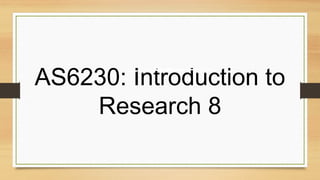
Introduction to Research Methods in the Social Services 08
- 3. Qualitative Research: What is it? Understanding the world we live in by answering questions like: How opinions and attitudes are formed? How people are affected by the events that go on around them? How and why cultures have developed in the way they have? What are the differences between groups?
- 4. The Reseacher’s Role “Being There”, “Getting Nosy” and “Looking Over Others’ Shoulders” (Wolcott, 1995)
- 5. The Four Main Types Phenomenology: describing events, situations, experiences or concepts. Ethnography: studying peoples and cultures Grounded theory : developing new theory Case study: studying a specific case or set of cases
- 6. The Researcher's Role Being a learner ‘Sucking in’ the atmosphere of the field Reflecting on your own experiences
- 7. The Researcher's Role the Emic Verses the Etic Emic (Insider) verses Etic (Outsider) diliemmas
- 8. Sampling in Qualitative (and some Mixed) Research Sampling in qualitative research never seeks to generalize to an entire population; it wants to tell a story from that population There is recognition of bias as the sample is non-random and often small The sample MUST represent some aspect of the phenomena being studied in the research question
- 9. Sampling in Qualitative Research: focus Maximum variation Homogenous sample selection Extreme case sampling Typical case sampling Critical case sampling Negative case sampling
- 10. Sampling in Qualitative/Mixed Research: Techniques Convenience/opportunistic Quota (choosing groups and numbers) Purposive/criterion-based Snowball Comprehensive
- 11. Your Turn Positivist/Post-Positivist Constructivist Feminist Ethnic Marxist Culture Mixed Select five sampling techniques Describe what questions they could answer for each paradigm Describe what types of cases you could focus on to answer your question Describe the limitations of each technique
- 12. Fieldnotes
- 13. Fieldnotes Sit alongside other techniques Detailed notes and reflections of the field Three types Descriptive Methodological Reflexive Occur after/before – rather than during
- 14. Descriptive Fieldnotes Include observations Describes the field – including maps, setting descriptions, and individuals
- 15. Methodological Fieldnotes Reflections on methodological approaches being used Notes on any changes to any approach being used
- 16. Reflexive Fieldnotes Journaling of own learning/experiences/ thoughts throughout the process May sit within or alongside descriptive and methodological notes Technically seen as journaling of experience
- 17. Dilemmas What dilemmas and issues to research does the practice of observation bring? How can fieldnotes counter these issues and dilemmas? What else can the researcher do to ensure that the story makes sense intrinsically (on an emic level) and extrinsically (on an etic level)?
- 18. Observation
- 19. Why Observe? To develop a theory To prove/disprove a theory Making use of an “opportunity” (Wolcott, 1995) Provide a thick description to analyse Provide an instrument of triangulation (alongside interviewing and fieldnotes)
- 20. What to observe Interactions Between people Between people and settings Between people and yourself Behaviours Reactions Routines Interactions The Context/Setting The overt and the covert
- 21. How? Traditional Eyes, pen, and paper Technological Cameras/Video/ICT Combination Trad+Post Even the post involves a level of the traditional
- 22. To what degree/level Four phases of observation Scoping Descriptive Focused Selective Each involves a different focus/depth
- 23. Phase One: Scoping Familisation with the setting Setting mapping Apparent rules/structures General impressions Your own reactions Any thoughts/hypotheses A reflexive tool Jottings and diagrams
- 24. Phase Two: Descriptive Detailed descriptions of settings, interactions, and behaviours Focuses on questions that can be addressed through observation - the inquisitive eye Uses delimiters and descriptors for current details and future reference
- 26. Phase Three: Focused Observation Descriptive observation focusing on specific descriptive questions: Space Objects Time Behaviours Individuals
- 27. Descriptive Questions Space Object Act Activity Event Time Actor Goal Feeling Space Object Act Activity Event Time Actor Goal Feeling From Spradley (1980)
- 28. Descriptive Questions Space Object Act Activity Event Time Actor Goal Feeling Space Object Act Activity Event Time Actor Goal Feeling
- 29. Phase Four: Selective Observation The focusing down of ‘focus observations’ Looks at filling in the gaps Providing other dimensions to focused observations and the phenomenon in question Focuses on the specifics Individual Event Behaviour Context
- 30. Observation and Technology What are the strengths of involving technology as an observation tool? What ‘new’ dilemmas arise from using technology as an observation tool? Do paper and pen still have a role to play alongside technology? What is this role?
- 31. Time to go Observing